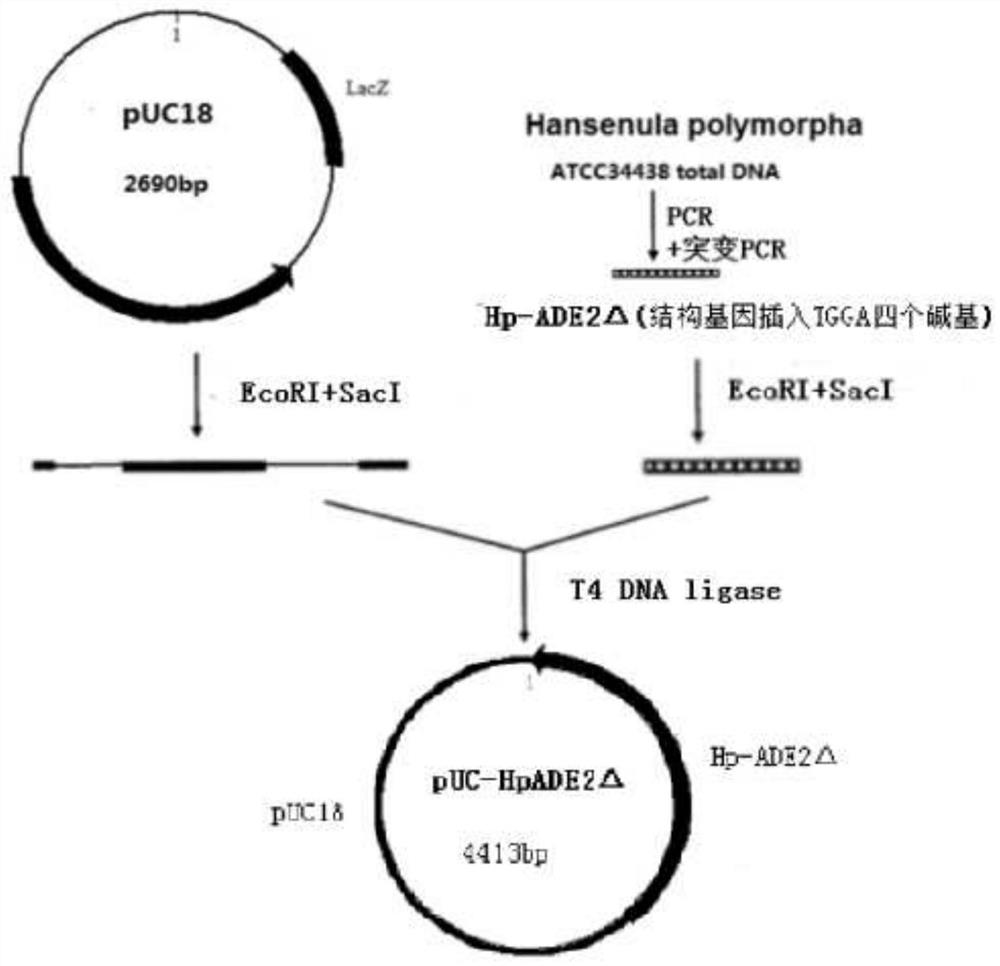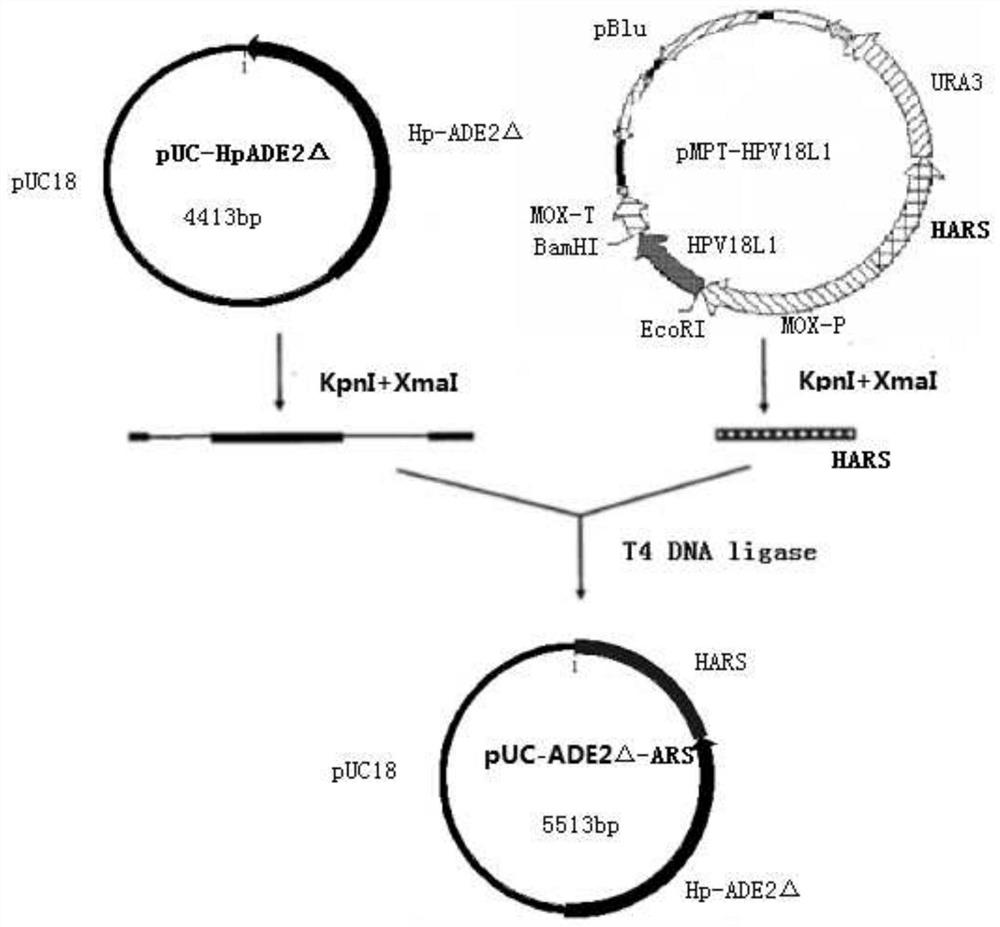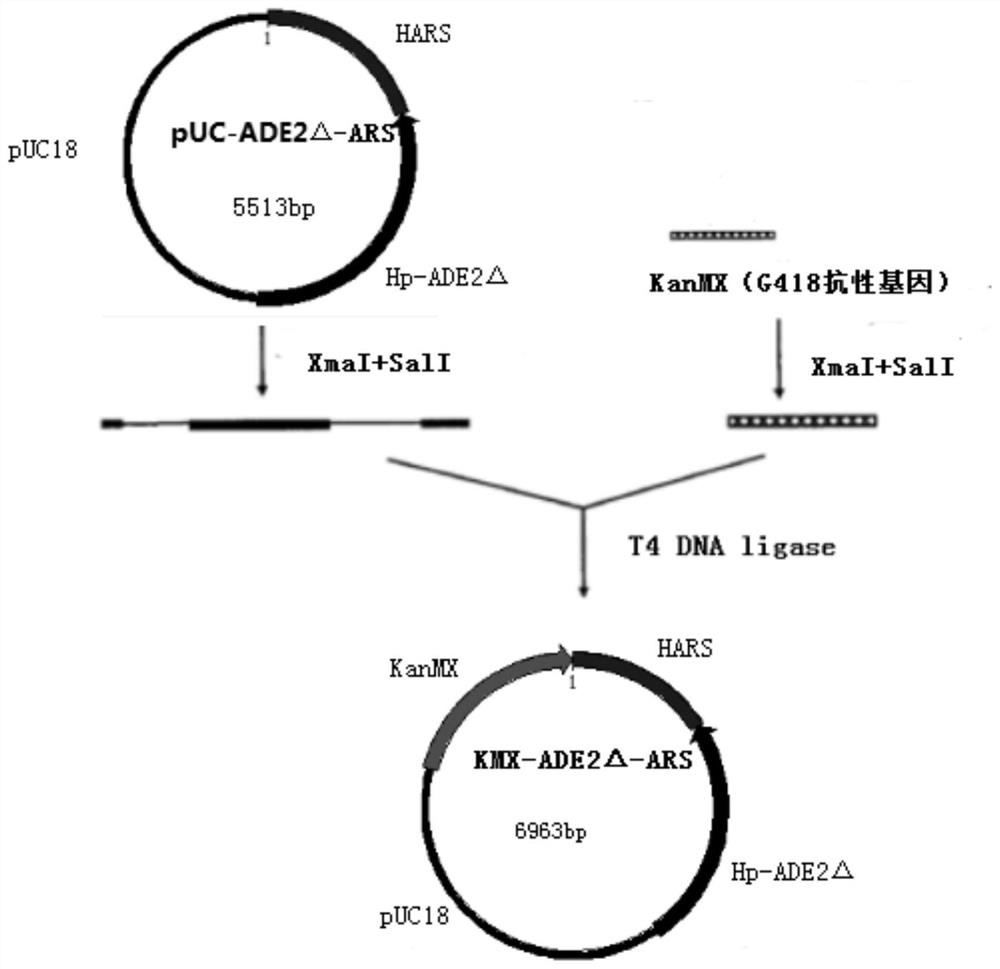A double-plasmid co-transformation genetically engineered bacteria with high expression of exogenous gene
A technology of genetically engineering bacteria and genes, applied in the field of bioengineering, can solve problems such as disadvantages
- Summary
- Abstract
- Description
- Claims
- Application Information
AI Technical Summary
Problems solved by technology
Method used
Image
Examples
Embodiment 1
[0069] Example 1 Construction and screening of dual auxotrophic receptor strains
[0070] 1. Obtain the Hansenula adenine gene (Hp-ADE2△) with structural gene mutation and construct the plasmid vector
[0071] Primers were designed according to the nucleotide sequence of the reported Hansenula adenine (ADE2) gene as follows:
[0072] Primer ADE-1 (SEQ ID NO: 1):
[0073]
[0074] (The underline is the restriction enzyme cutting site EcoRI, and the bold TGGA is the insertion mutation base of the ADE2 structural gene)
[0075] Primer ADE-2 (SEQ ID NO: 2):
[0076] 5'-AC GAGCTC CTATTTATTAAGGTATTCTTCAT-3'
[0077] (Stroke is the restriction enzyme cutting site SacI)
[0078] Using the total DNA of Hansenula polymorpha (ATCC34438) as a template, use primers ADE-1 and primers ADE-2 to amplify the mutant Hp-ADE2△, PCR system: premixed Pfu DNA polymerase 25 μL, template 1 μL, primers 1 μL, supplemented with ultrapure water to 50 μL and mix well; use a PCR instrument (PC707-0...
Embodiment 2
[0112] Embodiment 2 expression vector construction
[0113] 1. Obtain MOX promoter terminator and Hansenula autonomously replicating sequence and construct recombinant vector pBlu-MP(18L1)-HARS
[0114] Digest our own plasmid vector pMPT-HPV18L1 (see invention patent CN201210013236.X, the HPV18L1 gene is inserted between the MOX promoter and terminator) with restriction endonucleases BssHII and KpnI, and agarose gel electrophoresis to recover and purify the large fragment MP(18L1)+HARS (containing MOX promoter terminator and Hansenula autonomously replicating sequence, 4433bp, SEQ ID NO:20), used for ligase connection to construct expression vector.
[0115] Using pBlueScript SK(+) as a template, design primers:
[0116] pB-01 (SEQ ID NO: 11):
[0117] 5'-TA GCGCGC TTGGCGTAATCATG-3'
[0118] (Stroke is the restriction enzyme site BssHI)
[0119] pB-02 (SEQ ID NO: 12):
[0120] 5'-GC GGTACC TG ACGCGT CACTGGCCGTCGTTTTACAACG-3'
[0121] (Strokes are restriction enzy...
Embodiment 3
[0143] Example 3 Construction of functional carrier
[0144] 1. Obtain Saccharomyces cerevisiae mother adenine (ADE2sc) gene and carry out the first step of vector replacement
[0145] Primers were designed according to the nucleotide sequence of the cerevisiae cerevisiae adenine (ADE2sc) gene as follows:
[0146] Primer Ad-01 (SEQ ID NO:20):
[0147] 5'-CA ACGCGT CGCTATCCTCGGTTCTGCATTG-3'
[0148] (Stroke is the restriction enzyme cutting site MLUI)
[0149] Primer Ad-02 (SEQ ID NO:21):
[0150] 5'-TA GGTACC TAACGCCGTATCGTGATTAACG-3'
[0151] (Stroke is the restriction enzyme cutting site KpnI)
[0152]Use the total DNA of brewer's yeast (S288c) as a template, primer Ad-01, primer Ad-02 to amplify the brewer's yeast adenine gene ADE2sc, and the PCR product is alcohol-precipitated and air-dried with restriction endonucleases MluI and KpnI, and agar Glycogel electrophoresis recovered and purified the digested fragment ADE2sc (SEQ ID NO: 22, the first and last 6 base...
PUM
 Login to View More
Login to View More Abstract
Description
Claims
Application Information
 Login to View More
Login to View More - R&D
- Intellectual Property
- Life Sciences
- Materials
- Tech Scout
- Unparalleled Data Quality
- Higher Quality Content
- 60% Fewer Hallucinations
Browse by: Latest US Patents, China's latest patents, Technical Efficacy Thesaurus, Application Domain, Technology Topic, Popular Technical Reports.
© 2025 PatSnap. All rights reserved.Legal|Privacy policy|Modern Slavery Act Transparency Statement|Sitemap|About US| Contact US: help@patsnap.com



